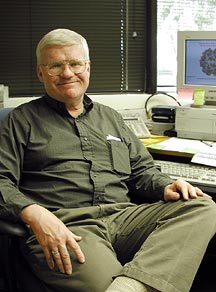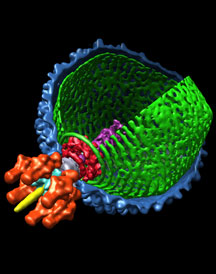

Study Suggests Virus Uses Pressure to Sense when Full of DNA
By Linley Hall
A team of scientists from The Scripps Research Institute, the University of Alabama, and the University of Utah has created a three-dimensional reconstruction of the complete structure of the virus P22. This structure suggests that the virus uses a pressure mechanism to stop DNA loading, a mechanism that offers a potential drug target. Although P22 only infects bacteria, its structure is similar to the herpes virus, types of which cause oral and genital herpes, chicken pox, and mononucleosis.
"If we're going to be able to control viruses and stop them from infecting people, we need to understand how they work," says John E. Johnson, professor of molecular biology at Scripps Research. "It's amazing to look at a structure like this and see how a virus could evolve such a mechanism."
The paper appears in the May 18 edition of ScienceXpress, the advance online edition of Science.
Viruses are particles that are little more than some DNA or RNA in a container made of proteins, called a capsid. Viruses require cells to reproduce, and are often classified according to their shape and what sort of genetic material they contain.
P22 is a spherical, double stranded DNA virus, whose capsid forms a nearly perfect icosahedron, a geometric shape with 20 triangular sides. A structure called a portal interrupts the perfect symmetry at one vertex and forms an opening to the capsid where the DNA enters and a tail eventually attaches.
Previous studies had used techniques such as x-ray crystallography to determine the structures of isolated pieces of P22, such as the portal or the tail. In contrast, Johnson and his colleagues used cryo-electron microscopy, or CryoEM, at the National Resource for Automated Molecular Microscopy at Scripps Research to create their reconstruction.
CryoEM offered the researchers several advantages. In negative stain electron microscopy the electrons bounce off the sample surface providing only an image of the virus exterior. In CryoEM, which uses transmission electron microscopy on frozen samples, however, electrons create three-dimensional images of a sample by passing through it. These 3D images encompass the entire viral particle, not just the surface. The researchers can then "slice and dice" the images any way they want, allowing them to peer inside the particle.
Because single images are noisy using this technique, the researchers used computer software to combine 26,000 images of P22 into a single reconstruction of the virus. Combining so many images improved the signal-to-noise ratio so that a clear picture of the virus emerged.
This picture showed two things about P22. First, DNA is tightly packed in the capsid, spooled around the center of the particle in coaxial circles. Second, the conformation of the portal could help indicate that the capsid was full.
As Johnson explains, "It looks like the DNA spools around the portal. It's like pulling a belt very tightly around a flexible object, like a balloon that's not fully inflated. The belt changes the shape of the balloon as you tighten it. Similarly, the DNA squeezes the portal so that the portal changes shape. Part of the portal is outside the capsid, and the conformational change signals the enzymes that are pumping DNA inside to stop."
The researchers were able to observe so much detail in the structure partly because of their imaging technique. Other CryoEM-based reconstructions of viruses use icosahedral symmetry to improve the image of the capsid exterior. Unfortunately, this blurs the internal structure and the tail. Johnson and colleagues used the tail to orient images but did not apply symmetry.
The researchers are now further testing their hypothesis about the portal's pressure sensor in P22. In the future, the work could be extended to other viruses as well.
"Very good evidence suggests that the herpes virus works the same way as P22," Johnson said. "We think it probably has a pressure sensor as well."
Other authors on the study include Gabriel C. Lander, Liang Tang, Clinton S. Potter, and Bridget Carragher of Scripps Research; Sherwood R. Casjens and Eddie B. Gilcrease of the University of Utah; and Peter Prevelige and Anton Poliakov of The University of Alabama at Birmingham.
The study was supported by the National Institutes of Health.
Send comments to: mikaono[at]scripps.edu

"It's amazing to look at a structure like this and see how a virus could evolve such a mechanism," says Professor John Johnson.

A new view of the virus P22.
